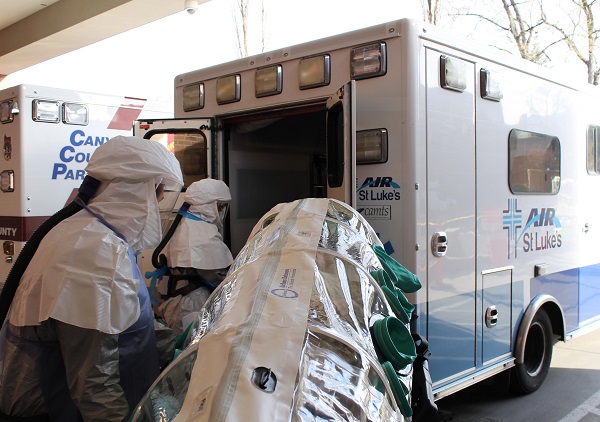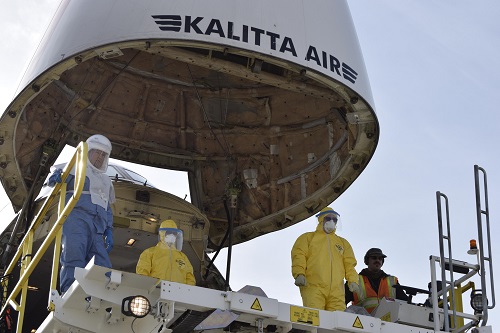St. Luke’s Joins Local Agencies in Nationwide Ebola Drill

One of the nation’s largest ever emergency preparedness drills took place around the country this week, including here in Idaho. A complex team of local, state and national agencies teamed up for three days to rehearse and hone their skills and capabilities for moving patients with a highly infectious disease, such as Ebola.
Over three days, teams from the U.S. Department of Health and Human Services, Boise Municipal Airport, St. Luke’s Health System, Saint Alphonsus, Air St. Luke’s, Ada County Paramedics, Central District Health Department, and the Idaho Department of Health and Welfare participated in the multi-regional, full-scale exercise stretching from Eagle to Boise.
The drill started early Monday morning when people acting as patients with Ebola symptoms arrived at various health care facilities around the region. The patients were cared for at the clinics and hospitals, then transported by ambulance to other facilities, before eventually being moved to Boise Municipal Airport/Gowen Field. Waiting for the patients and teams, a Kalitta Air 747 medical transport aircraft prepared to fly the patients to regional treatment centers in Spokane, Wash. and Los Angeles.
Throughout the exercise, participants react as if the incident is real. They must take the necessary actions and employ the appropriate resources to manage and protect the patients, the workforce, and the environment and safely transport the patients.
At each facility, health care workers collected and shipped samples for diagnostic tests to state laboratories, which in turn practiced running the necessary laboratory tests to diagnose the patients with Ebola. As part of the exercise, each patient received a positive diagnosis. Using appropriate isolation techniques and personal protective equipment, health care workers then took the steps required to have the patients transported by air to designated Regional Ebola Treatment Centers. These patients were placed into mobile biocontainment units for these flights. The pediatric patient was placed into protective equipment and transported by ground ambulance.

The local efforts were part of the largest patient movement exercise in the history of the U.S. Department of Health and Human Services (HHS) to test the nationwide ability to move patients with highly infectious diseases safely and securely to regional treatment centers.
“Saving lives during crises requires preparation and training,” said Robert Kadlec, M.D., HHS Assistant Secretary for Preparedness and Response. “A tremendous amount of coordination, synchronization, and skill is needed to move patients with highly infectious diseases safely. We have to protect the patients and the healthcare workers caring for those patients. This type of exercise helps ensure that everyone involved is ready for that level of complexity.”
Coordinated by the HHS Office of the Assistant Secretary for Preparedness and Response, more than 50 organizations across the county are participating, including the Department of State, Department of Transportation, the Regional Ebola Treatment Centers, local and state health and emergency management agencies, hospitals, airport authorities, and non-government organizations.
HHS and the Department of State previously collaborated on exercises to move Americans acting as Ebola patients from West African countries to Ebola treatment centers in the United States. In public health emergencies or disasters, the U.S. government orchestrates the return of Americans to the United States, including Americans who are sick or injured.
This exercise concluded Wednesday, April 12. Participants gathered on April 13 to assess the exercise, compare actions across the country, and share best practices for moving patients with highly infectious diseases.
“Working with our incredible local partners, this exercise was chance for St. Luke’s teams to take the lessons and practices we consistently train for, and apply them during a real-life, large-scale scenario,” said Lisa Spanberger, St. Luke’s disaster preparedness officer. “While we hope to never have to deploy these skills, it’s valuable to have that hands on experience, and after this week our teams not only feel more confident in the training they’ve had, but identified additional areas where we can concentrate in the future.”About The Author

Anita Kisseé was the Treasure Valley public relations manager for St. Luke’s Health System.
